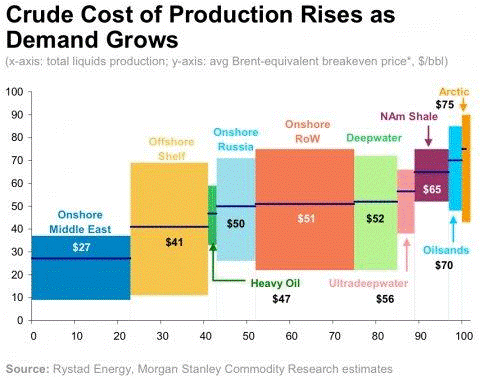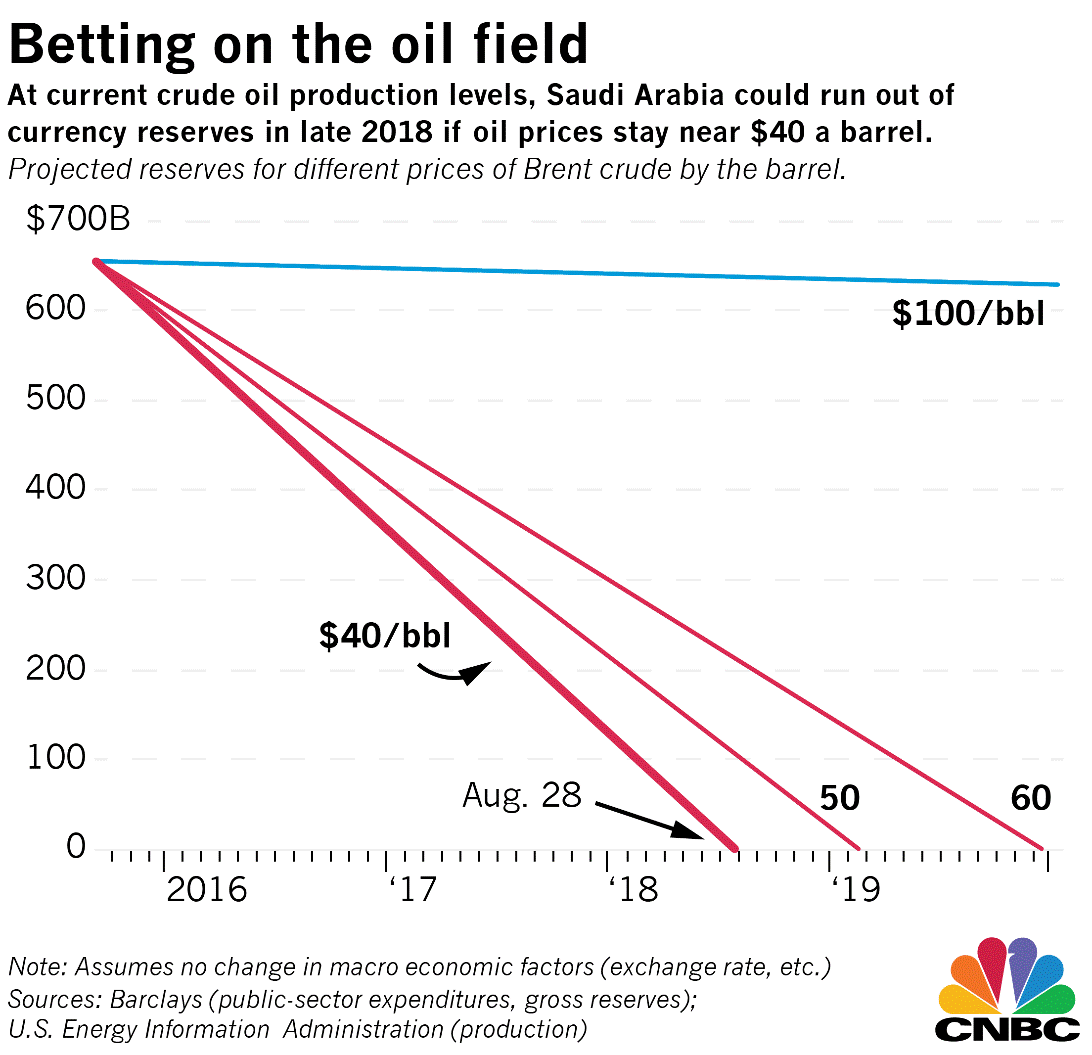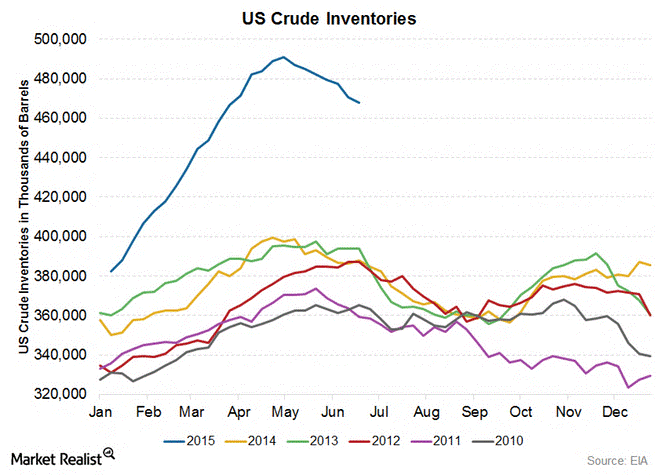The oil war has finally reached its tipping point after 13 long months. This struggle between Saudi Arabia, and its much smaller North American adversaries has recently shifted as the application of innovative extraction technologies is now gaining the upper hand.
The fiscal damage to national budgets is reaching a breaking point as surpluses have become deficits. Once stable nations face the possibility of having to drastically slash spending as this war has raged risking social instability.
Saudi Arabia has figuratively blinked after going eye to eye with the smaller and more nimble players. The question now is how much longer will this war drag on until energy markets once again stabilize, allowing oil-producing nations to balance their budgets.
It would be shortsighted to conclude that record low oil prices would not eventually limit future supply, and impair Petrostate economies. Each future barrel of oil has a production cost that needs to be met in order for supply to keep up with annual demand growth, as well as compensate for annual well depletion. This translates into producers having to find and replace between 4 percent and 6 percent annually in a market that is currently oversupplied between 1-to-2 percent.
Crude production is a capital-intensive undertaking, as well as being highly dependent upon massive amounts of debt-sourced financing. No private company can continue producing oil at a loss for an extended period of time, and no sovereign nation can operate at a loss without eventually destroying its currency and economy—case in point: Venezuela. Last week the market’s dynamics significantly flipped for the first time in over a year.
The public mistakenly believes that worldwide oil consumption has stopped growing through this pricing rout—it has not. Annual growth runs around one million barrels per year. It has been the overall increase in supply, not a demand decrease, which has been primarily responsible for driving prices down over 60 percent during these last twelve months.
OPEC has officially said it would produce at an upper limit of 30 million barrels per day, but is in reality producing 32.1 million bbl per day. This number is just shy of its record high 32.8 million bbl/day set back in the July of 2008. This figure additionally appears to be the group’s production limit without unsanctioned Iran. Every nation is essentially pushing as much oil onto the market a possible in an effort to make up for the lower prices.
Saudi Arabia is the largest member of OPEC and the only producer that can truly curtail production (the other members ALWAYS cheat). It is currently hemorrhaging some $14 billion a month, and has just resorted to borrowing money for the first time in eight years—fighting a price war it cannot win. Their foolish gambit may have slowed, but cannot stop, North American producers.
When 90 percent of your government’s financing is contingent upon prices remaining above $100 to function, it is a huge mistake to go up against American ingenuity, which keeps finding ways to produce at lower and lower prices.
Here are the price levels needed to prevent these Petrostates from running fiscal deficits, given current budgetary constraints, according to the WSJ:
Libya $215.00
Algeria $111.10
Saudi Arabia $103.00
Iran $92.50
Venezuela $89.00
Nigeria $87.90
Russia $78.00
U.A.E. $73.10
Iraq $70.90
Qatar $59.10
Kuwait $47.10
North American producers have responded to the drop in prices by cutting higher-cost production, and preserving capital by slashing future investments. These cutbacks are working, but they are temporarily taking with them many high-paying jobs. This running lean response has been coupled with massive experimentation into production methods that lower overall cost of producing oil at profitable prices. Higher (non-profitable) sources are being mothballed, while technological solutions keep driving the overall cost curve lower allowing firms to survive.
The latest U.S. Energy Information Administration data shows that U.S. production has fallen from a 40-year high of 9.6 million barrels per day back in April, to the 9.27 million barrels per day in June. This declining trend should continue as commercial hedges put in place, back when prices were higher, expire. The current surplus that had been rapidly growing for months is now slowly reversing.
Frackers are innovating their way to lower break-even pricing using disruptive technologies. Some estimates say the fracking cost for some firms has dropped by more than $10 a barrel from a year ago, and will continue to drop even further. These innovations were something the Saudi’s never counted on when they made their decision to not restrict production last November.
The variable in question now is the timeframe in which to once again reach a true equilibrium price where supply and demand are balanced without manipulation. The Saudi’s strategy of not reducing production is finally starting to fail, helped along by the Yemen War, which has now entered the costly boots on the ground stage.
The Saudi’s recent move to borrow money is the canary in the coal mine, signaling their inevitable surrender. They will soon have to cut production on their end to stabilize prices—either by themselves or with the assistance of other OPEC members. Many countries are so heavily dependent on oil revenue that societal collapse is possible for those that can no longer pay their bills. If the current sub-$50 prices prevail, Saudi Arabia will burn through all of their foreign currency reserves in less than four years.
“Drill, baby, drill” has worked, but at the expense of many smaller U.S. firms that have higher costs and larger debts. A painful retracement should now begin as budgeting for the maintenance and upkeep of existing wells has been slashed, and as exploration for new sources of crude has ground to a virtual standstill across the globe.
Surviving the next quarter is the focus for many firms as bankers come knocking, looking for reassurances that they will be paid back on over $550 billion of already highly questionable loans. North American firms, although wounded, are in the better position than Saudi Arabia to ride out the price war.
The additional supply that many were counting on (aside from the lifting of Iranian sanctions) now appears unlikely, as these large debt obligations overwhelm profit margins across the globe. Bankers don’t lend money to businesses that don’t make a profit—and at these price levels, lending is drying up. This should painfully unfold over the next six-to-twelve months.
This breakdown in prices has been painful for the entire sector; it has destabilized many regions around the globe. The lasting legacy of this pricing war will be that in order to make deals that will provide needed new supply, future lenders are going to demand much more stringent and costly terms. This added risk premium will be built into pricing models, and, unfortunately, passed on to consumers in the form of higher prices at the pumps. The days of cheaper trips to the pump will likely be over by next summer, and those who bet against the return to higher prices will soon regret those SUV purchases.
Disclaimer: Nothing in this article should be viewed as a reason to buy or sell any security.





COMMENTS
Please let us know if you're having issues with commenting.